
The Irish Republican Army was an Irish republican revolutionary paramilitary organisation. The ancestor of many groups also known as the Irish Republican Army, and distinguished from them as the Old IRA, it was descended from the Irish Volunteers, an organisation established on 25 November 1913 that staged the Easter Rising in April 1916. In 1919, the Irish Republic that had been proclaimed during the Easter Rising was formally established by an elected assembly, and the Irish Volunteers were recognised by Dáil Éireann as its legitimate army. Thereafter, the IRA waged a guerrilla campaign against the British occupation of Ireland in the 1919–1921 Irish War of Independence.

The Irish War of Independence or Anglo-Irish War was a guerrilla war fought in Ireland from 1919 to 1921 between the Irish Republican Army and British forces: the British Army, along with the quasi-military Royal Irish Constabulary (RIC) and its paramilitary forces the Auxiliaries and Ulster Special Constabulary (USC). It was part of the Irish revolutionary period.

The Auxiliary Division of the Royal Irish Constabulary (ADRIC), generally known as the Auxiliaries or Auxies, was a paramilitary unit of the Royal Irish Constabulary (RIC) during the Irish War of Independence. It was founded in July 1920 by Major-General Henry Hugh Tudor and made up of former British Army officers, most of whom came from Great Britain and had fought in the First World War. Almost 2,300 served in the unit during the conflict. Its role was to conduct counter-insurgency operations against the Irish Republican Army (IRA), acting mainly as a mobile striking and raiding force. It operated semi-independently of the RIC and was mainly deployed to southern and western regions where fighting was heaviest.

Thomas Bernardine "Tom" Barry was a prominent guerrilla leader in the Irish Republican Army (IRA) during the Irish War of Independence, when he was commander of the 3rd West Cork Flying Column. During the Irish Civil War, he was a leader of the Anti-Treaty IRA.
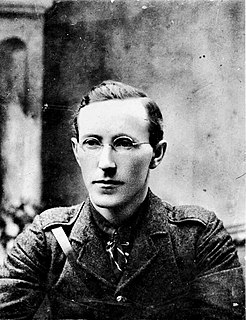
Liam Lynch was an officer in the Irish Republican Army during the Irish War of Independence and the commanding general of the Irish Republican Army during the Irish Civil War.
Thomas Hales was an Irish Republican Army (IRA) volunteer and politician from West Cork.
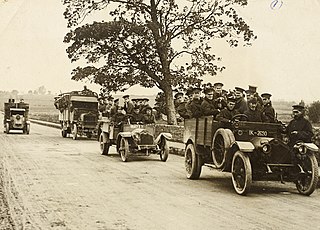
This is a timeline of the Irish War of Independence of 1919–21. The Irish War of Independence was a guerrilla conflict and most of the fighting was conducted on a small scale by the standards of conventional warfare.

Collins Barracks is a military barracks on the Old Youghal Road on the north side of Cork in Ireland. Originally serving as a British military barracks from the early 19th century, it was handed-over to the Irish military following the Irish War of Independence, and remains the headquarters of the 1st Brigade of the Irish Army. A museum in the barracks is open to the public at selected times.
Thomas McEllistrim was an Irish Fianna Fáil politician who served as a Teachta Dála (TD) from 1923 to 1969. He was a military activist in the period from 1916 to 1923.
Charles Hurley was Officer Commanding of the 3rd Cork Brigade of the Irish Republican Army during the Irish War of Independence (1919–1921)
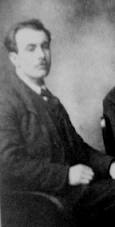
Séumas Robinson was an Irish republican and politician.

Seán Allis Treacy was one of the leaders of the Third Tipperary Brigade of the Irish Republican Army during the Irish War of Independence. It was his actions that initiated the conflict in 1919. He was killed in October 1920, on Talbot Street in Dublin, in a shootout with British troops and spies during an aborted British Secret Service surveillance operation.
Maurice Moore was an Irish republican who fought in the Irish War of Independence. In April 1921 Moore was executed in the military prison of Victoria Barracks after being captured in the aftermath of the Clonmult Ambush.

Michael Kilroy was an Irish politician and guerrilla leader. He was an Irish Republican Army (IRA) officer in his native County Mayo during the Irish War of Independence and Irish Civil War. Subsequently, he was a Sinn Féin and later Fianna Fáil Teachta Dála (TD) for Mayo South.
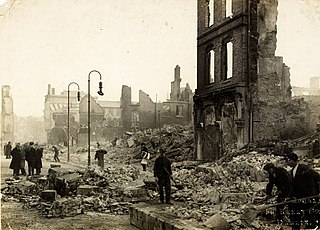
The burning of Cork by British forces took place on the night of 11–12 December 1920, during the Irish War of Independence. It followed an Irish Republican Army (IRA) ambush of a British Auxiliary patrol in the city, which wounded twelve Auxiliaries, one fatally. In retaliation, the Auxiliaries, Black and Tans and British soldiers burned homes near the ambush site, before looting and burning numerous buildings in the centre of Cork, Ireland's third-biggest city. Many civilians reported being beaten, shot at, and robbed by British forces. Firefighters testified that British forces hindered their attempts to tackle the blazes by intimidation, cutting their hoses and shooting at them. Two unarmed IRA volunteers were also shot dead at their home in the north of the city.
The 3rd Cork Brigade, also known as Third (West) Cork Brigade was a unit of the Irish Republican Army that operated in the western areas of County Cork during the Irish War of Independence. The unit was commanded by Tom Barry for most of the conflict and was responsible for the Kilmichael Ambush and Crossbarry Ambush.
The Tooreen ambush was an ambush carried out by the Irish Republican Army (IRA) on 22 October 1920, during the Irish War of Independence. It took place near Roberts Farm, Tooreen, near Ballinhassig in County Cork. The IRA ambushed two lorries of British soldiers, killing three and wounding four others. The British surrendered and their weapons and ammunition were seized by the IRA. Later that night, British soldiers went on a rampage in nearby Bandon.
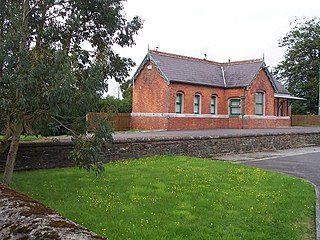
The Upton train ambush took place on 15 February 1921, during the Irish War of Independence. The Irish Republican Army (IRA) mounted an attack on a train carrying British soldiers at Upton, County Cork. The action was a disaster for the IRA; three of its volunteers were killed and two wounded. Six British soldiers were wounded, three seriously. Six civilian passengers were killed and ten wounded in the crossfire.
Sean C. Finn was a commander of multiple units in the IRA's Irish War of Independence in the early 20th century. He led many attacks on the Black and Tans and the heavily-armed RIC patrols, with his brigade usually armed only with shotguns.

The Sack of Balbriggan took place on the night of 20 September 1920, during the Irish War of Independence. British police officers known as Black and Tans went on a rampage in the small town of Balbriggan, County Dublin, burning more than fifty homes and businesses, looting, and killing two local men. Many locals were left jobless and homeless. The attack was revenge for the murder of two police officers in Balbriggan by the Irish Republican Army (IRA). It was the first major 'reprisal' attack against an Irish town during the conflict. The sack of Balbriggan drew international attention, leading to heated debate in the British parliament and criticism of British government policy in Ireland.











